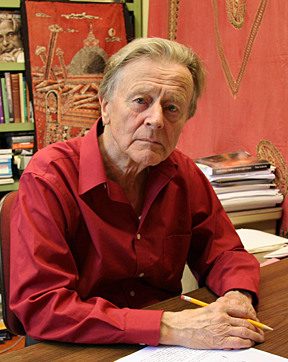Professor Tom Gehrels: 50 years at the UA
 Professor Tom Gehrels was recognized for his 50 years of service at the annual University of Arizona Service Awards luncheon, held on April 13, 2011.
Professor Tom Gehrels was recognized for his 50 years of service at the annual University of Arizona Service Awards luncheon, held on April 13, 2011.
Professor Tom Gehrels joined the UA's Lunar and Planetary Laboratory (LPL) in 1961 as an Associate Professor. He earned his B.S. in Physics and Astronomy from Leiden (Netherlands) University in 1951, and his Ph.D. in Astronomy and Astrophysics from the University of Chicago in 1956. While in Chicago, he worked with Subrahmanyan Chandrasekhar and Gerard P. Kuiper (who founded LPL in 1960). Dr. Gehrels' distinguished science career features many highlights. During the 1950s, Professor Gehrels pioneered the first photometric system of asteroids and discovered the opposition effect in the brightness of asteroids. In the 1960s, he pioneered wavelength dependence of polarization of stars and planets. His research interests then migrated to imaging photopolarimetry of Jupiter and Saturn, and Dr. Gehrels was named principal investigator for the Pioneer 10 and 11 Imaging Photopolarimeters, which discovered Saturn's F ring.
In 1980, Tom Gehrels founded the SPACEWATCH® Project, which uses telescopes on Kitt Peak to survey the sky for dangerous asteroids; he led the project until 1997. Professor Gehrels also founded the well known and well respected Space Science Series, still published by the University of Arizona Press. He served as general editor for the first 30 volumes of the series. At its start in the 1980s, the Space Science Series represented a new way of producing research textbooks.
In 2007, Tom Gehrels was the recipient of the Harold Masursky Award, presented by the American Astronomical Society's Division for Planetary Sciences in recognition of meritorious service to planetary science. Professor Gehrels' current research interest is universal evolution. Each fall, he teaches an undergraduate course for non-science majors and each spring, he presents a brief version of that course at the Physical Research Laboratory in Ahmedabad, India, where he is a lifetime Fellow.

